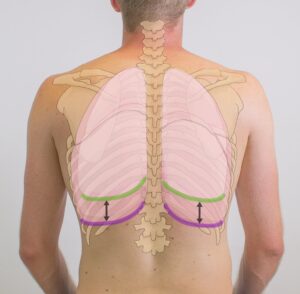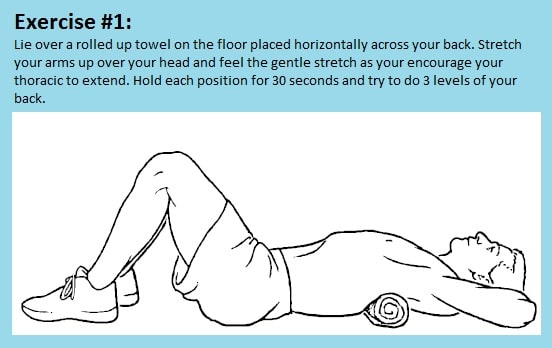By Andrew Siyabalawatte, posted April 2021.
What’s The Connection?
Let’s unravel the mystery. Meet the diaphragm, the silent force beneath your ribcage, with a direct line to your spine. It tirelessly collaborates with every breath you take.
But why does the back hurt when you breathe? Let’s explore the captivating interplay between our breathing and our back. We’ll delve into how they move together and, at times, experience a less-than-harmonious duet.

Why Does My Upper Back Hurt When I Breathe?
Right, now take a deep breath and with your hands (one on the chest and one on the back), try and feel the structures that move on the front of your body – you should notice the ribs elevate, the chest expand and the abdomen fill with air.
You should also feel how the upper, middle and lower back also expand and depress as you breathe in and out – see the connection?
Did you know the apex (top) of the lung sits at the 1st rib, just below the shoulders? the shoulder blades, connect to the collar bone which attaches to the ribcage. The short answer, this is one reason why the upper back hurts when you breathe.
A Herniated Disc and Breathing
It’s essential to acknowledge that various factors contribute to lower back pain when breathing. For example, a herniated disc can directly influence breathing mechanics as the muscles protecting the disc will be more focused on that, therefore the breathing pattern will automatically alter itself to accommodate.
From a structural perspective, poor posture is a significant factor. Prolonged periods of sitting, especially at a desk, can directly impact breathing. In simple terms, “slouching” due to overused core muscles and overstretched back muscles can compress the diaphragm, reducing its ability to expand and flatten, leading to breathing issues.
This reduces the space for the diaphragm to expand and flatten and thus, leads to breathing issues.
The Negative Effect Of Poor Breathing
From my experience in clinic, I often find that people who have constant or intermittent back pain for months or years even, have some form of breathing issue. I believe this issue develops over time as a “defence mechanism” to protect the back by tightening or recruiting the core muscles to engage more than they need to. This is why Osteopathic treatment of the diaphragm for example, can potentially alleviate symptoms of back pain almost immediately.

If you find yourself grappling with back pain while breathing for example, if your experiencing a shortness of breath or if you’re coughing up blood, prompt medical attention is absolutely crucial.
Improve Ribcage Function
The exercise shown below focuses on gently decompressing the spine to help open out the ribcage and bring more air in. Focus on breathing in a slow controlled manner through the mouth to fill the abdomen during the stretch.

Train The Diaphragm
The diaphragm is the muscle that’s responsible for 80 percent of your breathing. This muscle’s main function is to support breathing, which can help your body adjust to increases in intensity during your workout. Like your other muscles, you can do exercises to train your diaphragm and boost your overall aerobic performance.
The exercises shown here focus on improving strength and endurance throughout whilst being mindful of respiration.
Did these exercises help? Book in with our back specialists and get the medical attention you need. We will help alleviate your back pain and help you address the issues affecting your breathing and chest pain concerns.
Apart from the structural and postural factors mentioned earlier, several other conditions can contribute to back pain when breathing.
1. Asthma
Asthma is a chronic respiratory condition characterized by inflammation and narrowing of the airways. During an asthma attack, the airways become inflamed and swollen, making it difficult to breathe. This can lead to increased use of the accessory muscles of respiration, including those in the back, which can result in back pain.
The hip mobility exercises shown here focus on people suffering from asthma by improving their overall respiratory function.
2. Muscle Strain
Muscle strain, often caused by overuse or improper lifting techniques, can also contribute to back pain when breathing. When the muscles in the back are strained, they can become tight and painful, especially during deep breathing.
3. Anxiety and Panic Attacks
Anxiety and panic attacks can cause rapid, shallow breathing, known as hyperventilation. This can lead to a sensation of breathlessness and chest tightness, which may be accompanied by back pain. Additionally, the muscle tension that often accompanies anxiety and panic attacks can contribute to back pain.
This 4-7-8 breathing exercise is a simple technique that can help promote relaxation, alleviate stress, and improve sleep, particularly beneficial for managing anxiety and panic attacks.
We specialize in holistic approaches to health and wellness, including the management of conditions like asthma, muscle strain, and anxiety and panic attacks. Our team of healthcare professionals can work with you to develop a personalized treatment plan that addresses the underlying causes of your back pain and helps improve your overall well-being.
From osteopathic treatments to physical therapy and stress management techniques, we offer comprehensive care to help you feel your best.
There it is, I hope you now know have a better understanding of why the back hurts when you breathe. If you need more engaging info, click here to read our December newsletter.

